Ever wondered how to make a small space feel both stylish and incredibly functional? Studio apartments have skyrocketed in popularity, especially in bustling cities, because they offer the perfect blend of convenience and modern living without sacrificing style. Their open, flexible layouts make them appealing for anyone looking to maximize every square inch while creating a cozy, personalized retreat.
When designed thoughtfully, a tiny space can feel spacious, organized, and uniquely yours. In this article, you’ll discover a wealth of clever layout ideas and practical tips to transform your studio into a smart, stylish sanctuary.
From space-saving furniture to creative zoning techniques, we’ll explore a variety of inspiring solutions that balance efficiency with eye-catching design. Whether you’re seeking ways to optimize storage, define different areas, or simply add a touch of personality, these ideas will help you craft a functional and beautiful home tailored to your lifestyle.
Maximizing space while maintaining style is a common challenge in studio apartments, and multi-functional furniture offers an elegant solution. These versatile pieces serve more than one purpose, reducing clutter and creating a streamlined look that feels both modern and cozy.
Imagine a sleek sofa bed with a plush, neutral-toned fabric that can transform from a comfy seating area during the day to a welcoming bed at night. Or consider a coffee table with hidden storage compartments, crafted from warm wood with a matte finish, where you can stow away blankets, books, or magazines.
These pieces often feature clean lines, subtle hardware, and minimalist designs that add to the aesthetic without overwhelming the space. The textures range from soft upholstery to smooth wood surfaces, and their compact footprints help keep the flow open and airy.
To implement multi-functional furniture in your space, start by selecting key pieces like a fold-out bed or a storage ottoman. Look for options in neutral shades like beige, gray, or soft pastels, which blend seamlessly with various decor styles.
You can find these at furniture stores or customize them with removable covers and cushions. Place the sofa bed in your living area, and position a storage ottoman near your seating for easy access. With a little planning, these pieces can dramatically improve your apartment’s functionality while elevating its style.
1. Using Vertical Storage Solutions for Clutter-Free Living
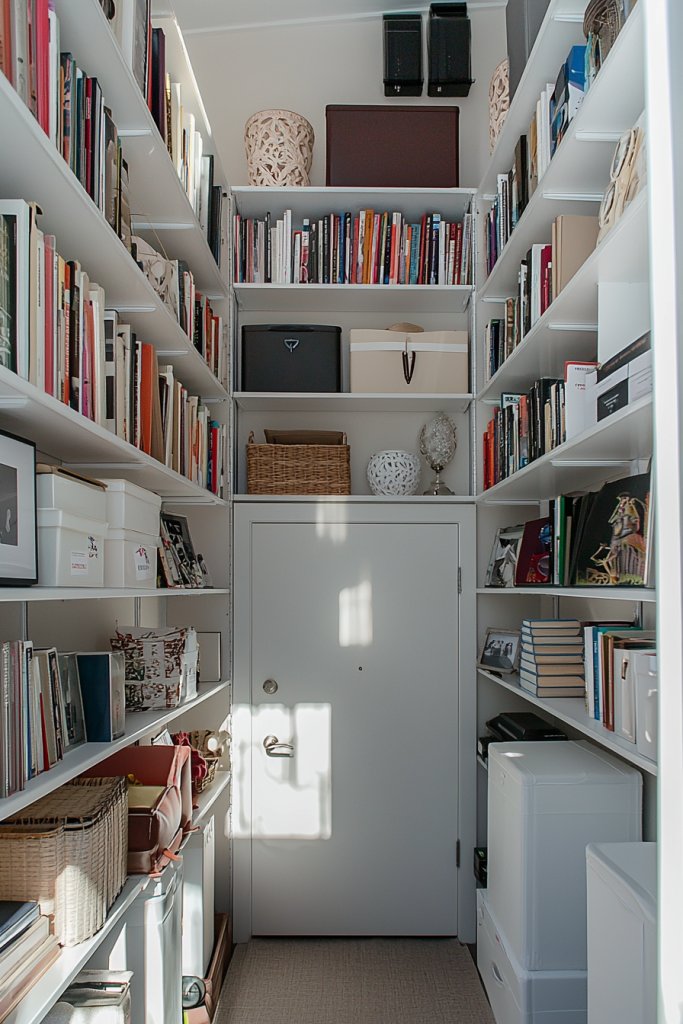
In a small studio, vertical storage isn’t just practical — it’s essential for creating an organized, clutter-free environment that feels spacious and inviting. By reaching upward, you free up precious floor space while adding visual interest and functionality.
Visualize tall, open shelving units made of light-colored wood or sleek metal, stretching from floor to ceiling, filled with books, decorative ceramics, or baskets. Floating shelves are another favorite, offering a minimalist look that can display your favorite accessories or store everyday essentials.
The key is to choose storage solutions that blend with your decor — think woven baskets, ceramic jars, or minimalist wire racks — to keep everything accessible yet tidy. The textures of these materials contrast beautifully with painted walls or wallpaper, adding depth and personality to your space.
To incorporate vertical storage, start by assessing your wall space and identifying areas for installation. Use floating shelves above your desk or bed for easy-to-reach storage, and consider tall cabinets or open shelving units in corners to maximize height.
Opt for lightweight, durable materials like birch plywood or powder-coated metal to ensure safety and longevity. Organize items by frequency of use, keeping everyday essentials at eye level. With vertical storage, your studio can stay neat without sacrificing style or comfort.
2. Creating Defined Zones with Area Rugs and Partitions
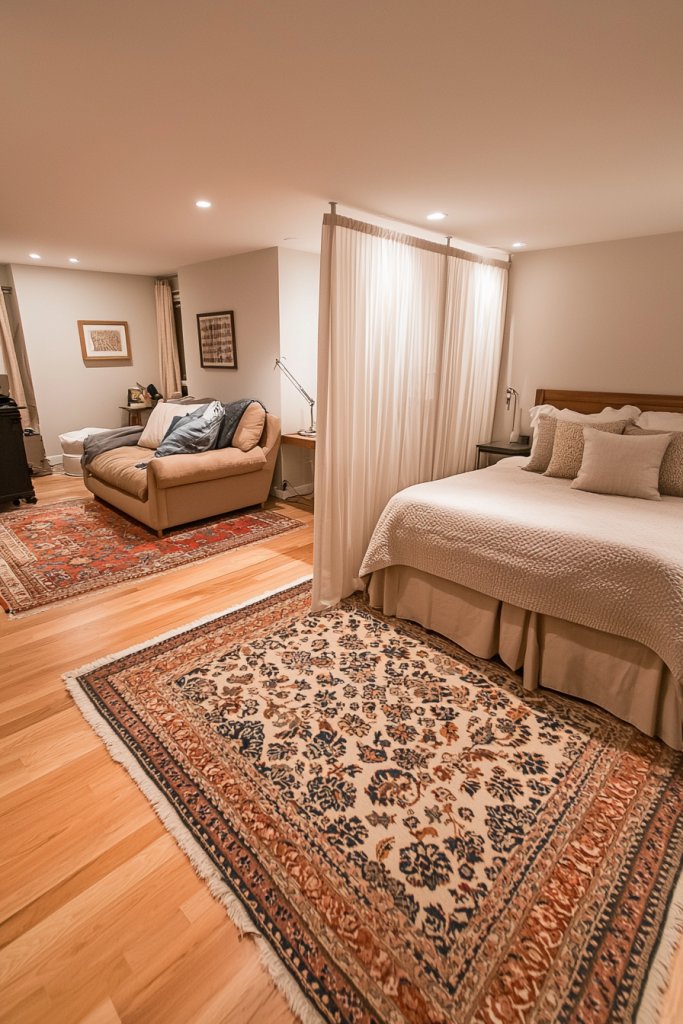
In a studio apartment, defining different functional zones — like sleeping, living, and dining areas — is crucial for both organization and aesthetics. Using strategic decor elements like area rugs and partitions transforms an open space into a series of cozy, purposeful sections.
Picture a plush, textured area rug in a soft gray or warm beige, delineating your sleeping area from the rest of the room. As you step onto it, you’re greeted with a sense of coziness that instantly signals “bedtime.” For added separation, sleek room dividers or folding screens in light wood or neutral fabrics can be positioned to carve out a workspace or lounge zone, creating visual boundaries without blocking light or airflow.
These partitions can be lightweight, portable, and stylish, with subtle patterns or textures that complement your overall decor. The rugs and dividers work together to create a layered, inviting space that feels organized and intentional.
To implement this idea, choose a rug that fits comfortably under your bed or seating area — typically 5×8 feet for a standard studio — and layer it with a soft throw and cushions for added comfort. For partitions, consider options like a fabric screen with metal frames or a set of lightweight wooden panels.
Position these elements thoughtfully to craft distinct zones, making your studio feel larger and more functional while adding visual interest. This simple yet effective approach makes your space feel curated and welcoming.
3. Opting for Open-Concept Layouts to Maximize Flow and Light
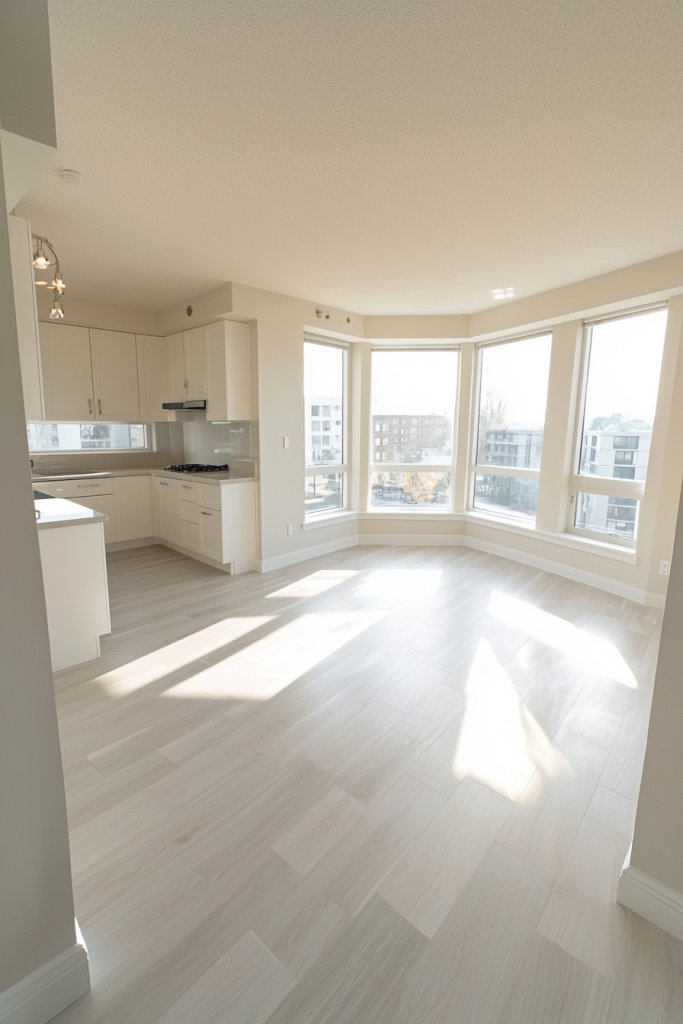
An open-concept layout is the cornerstone of a spacious, airy studio, fostering a seamless flow between different functional zones while maximizing natural light. Removing unnecessary walls makes the space feel larger and more inviting, perfect for modern living.
Visualize a bright, airy room bathed in sunlight, with minimal furniture cluttering the space. The layout integrates the living, sleeping, and dining areas into one cohesive environment, with furniture carefully arranged to define each zone without barriers.
Light-colored walls and reflective surfaces like mirrors amplify the sense of openness, while sleek, low-profile furniture ensures unobstructed sightlines. The overall aesthetic is minimalist, with a focus on clean lines, neutral tones, and subtle textures like linen curtains or soft rugs, creating a calming, spacious atmosphere.
To achieve this layout, start by selecting multi-purpose furniture that can serve multiple functions — like a sofa bed or compact dining table. Arrange your bed or sleeping area against a wall or in a corner, leaving the central space open for lounging or entertaining.
Use light-colored paint and strategically placed mirrors to enhance brightness and depth. Keep pathways clear to ensure easy movement and foster a sense of freedom throughout your apartment. This approach transforms a small space into a versatile, welcoming home that feels much larger than it is.
4. Utilizing Floating Shelves for Decor and Storage in Small Spaces
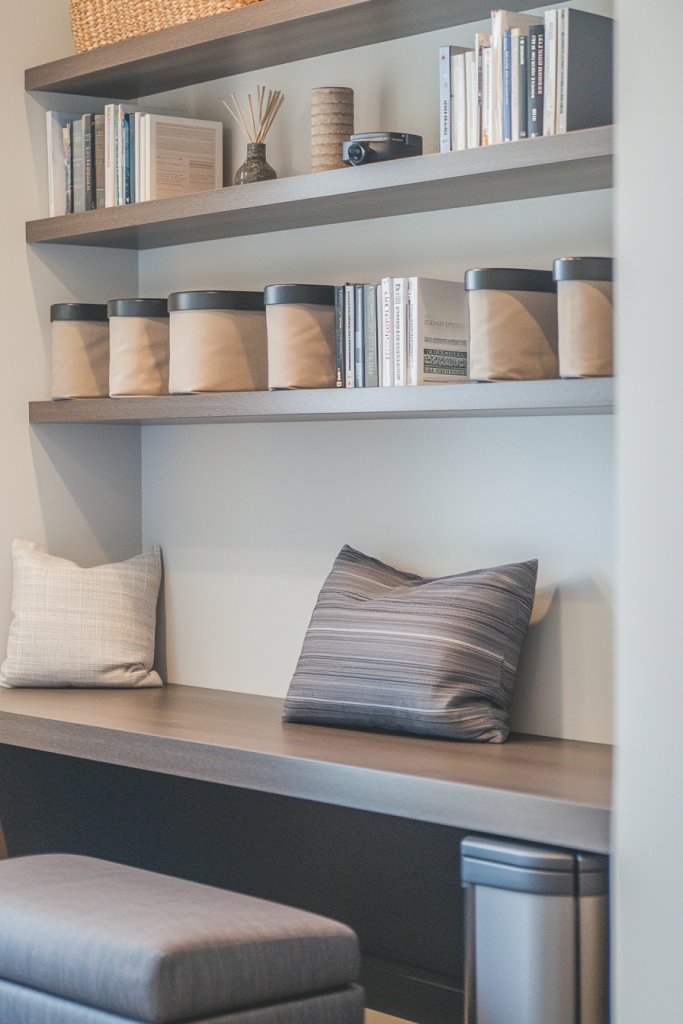
Maximizing both style and function, floating shelves are a game-changer for small studio apartments. They create a sleek, modern look while providing essential space for decor and storage without cluttering the floor.
These shelves can be installed at varying heights, allowing you to display favorite ceramics, small plants, or cherished mementos, adding personality to your space. Imagine a set of white or natural wood floating shelves mounted along a wall, holding a mix of textured ceramics, framed photos, and a few decorative books.
The clean lines and minimalist design make the room feel open and airy, while the varied heights and arrangements add visual interest. Soft lighting underneath the shelves can make the display pop and create a cozy ambiance, especially in the evenings.
The overall effect is a personalized gallery that seamlessly blends practicality with aesthetics. To implement this idea, start by choosing sturdy floating shelf brackets and selecting your preferred shelf material, like reclaimed wood or sleek MDF.
Measure and mark the desired heights on your wall for even spacing, then drill and secure the brackets. For a beginner-friendly approach, opt for pre-finished shelves that require minimal assembly. Decorate by arranging your favorite small objects in a balanced, visually appealing way, and consider adding LED strip lights underneath for extra warmth and brightness.
5. Clever Bed Placement to Maximize Floor Space
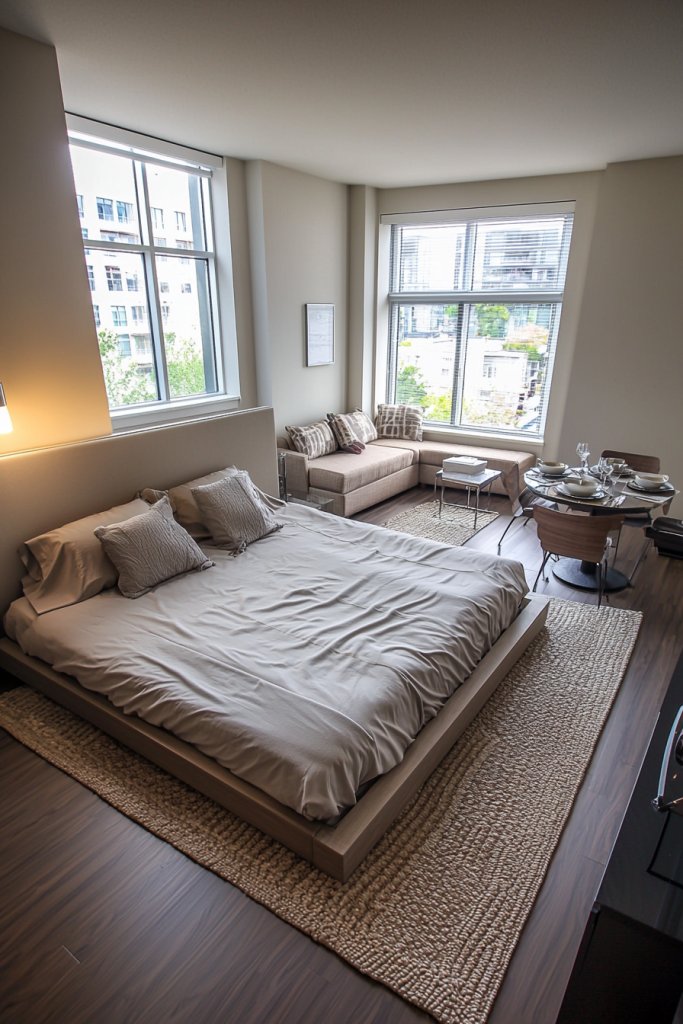
In a studio apartment, where every square foot counts, strategic bed placement can dramatically open up your living area. The key is to position your bed in a way that creates clear zones, enhances flow, and keeps the space feeling uncluttered and inviting.
Visualize your bed tucked into a corner or along a wall, ideally away from the main entry pathway. Using a platform bed with under-bed storage helps utilize space efficiently, while placing the bed against a wall allows for more open space in the center for a small seating or dining area.
Opting for a low-profile bed with a minimalist frame adds to the sense of openness and prevents the room from feeling cramped. Incorporating a bed with built-in drawers or storage bins minimizes clutter and maximizes functionality.
To achieve this, measure your space carefully and choose a bed size proportionate to your apartment’s dimensions—preferably a full or twin size. Position the bed so it doesn’t block windows or doorways, and consider placing it against a wall that allows for easy access from both sides if needed.
Use nightstands with storage or avoid bulky furniture altogether. This simple adjustment in placement creates a more spacious, organized environment that feels both relaxing and efficient.
6. Modular Furniture Pieces for Flexible Living Arrangements
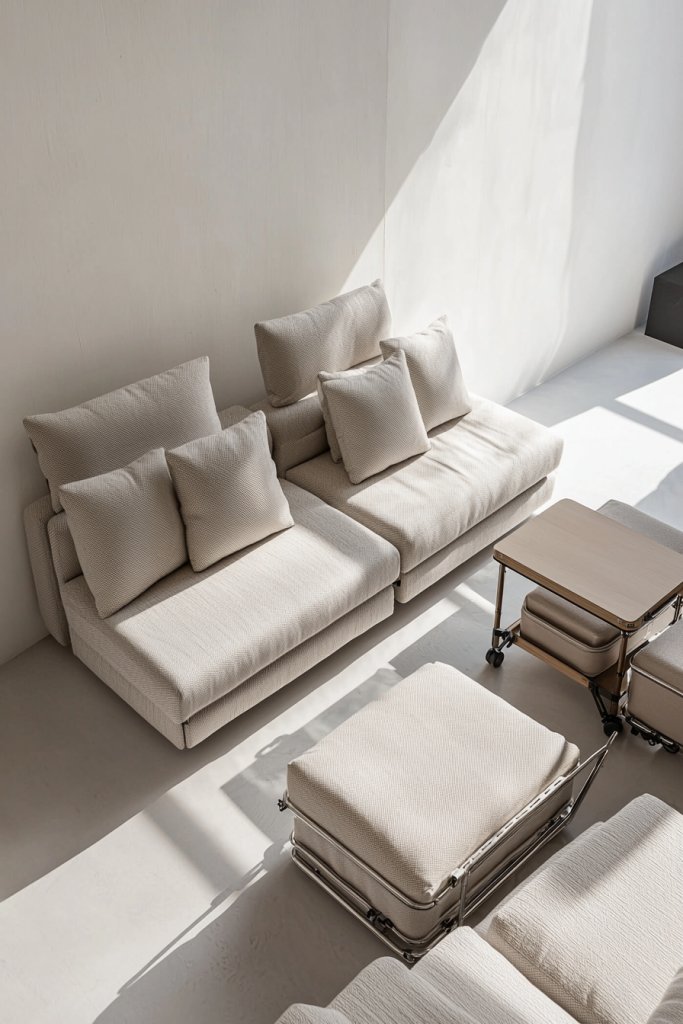
Modular furniture is the ultimate solution for adaptability in a small studio, offering customizable configurations that grow with your needs. These versatile pieces can serve multiple functions—from sofa to bed, or dining table to storage—making your space highly functional without sacrificing style.
Picture a modular sofa with detachable sections, allowing you to reconfigure it into a lounge, guest bed, or even a cozy nook. Pair it with stackable or foldable tables that can be expanded when needed or tucked away to save space.
Use interchangeable storage units that can act as side tables, shelves, or footstools, adding to the room’s flexibility. This approach encourages a minimalist aesthetic with clean lines and neutral tones, which helps keep the space feeling open.
Begin by selecting a core set of modular pieces—such as a sectional sofa with removable cushions or a multi-purpose dining table—that fit your lifestyle. Look for options with hidden storage compartments to reduce clutter.
Assembly is usually straightforward, and many brands offer online tutorials. By choosing adaptable furniture, you create a dynamic living space that can easily shift from relaxing to entertaining, all while maintaining a sleek, cohesive look.
7. Combining Minimalist Design with Bold Accent Colors
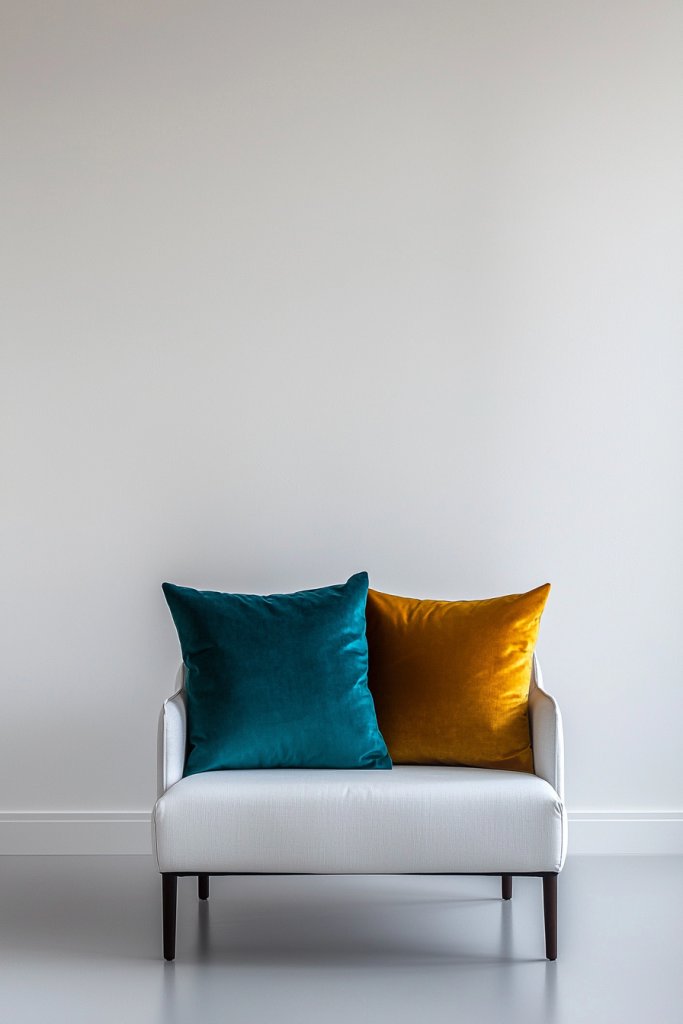
Balancing simplicity with striking accents is a proven way to elevate a studio apartment’s style. A minimalist foundation—neutral walls, clean lines, and uncluttered surfaces—provides a calm, spacious backdrop.
Adding bold accent colors creates visual interest and personality without overwhelming the space. Envision a room with white walls and light-colored furniture accented by a vibrant emerald green throw pillow, a deep navy rug, or a ruby red vase.
Incorporate textures like a soft, chunky knit blanket or a plush velvet cushion to add depth. Metallic finishes, such as brass or matte black fixtures, enhance the contemporary vibe while complementing bright pops of color.
The contrast draws the eye and creates focal points that make the space feel curated and lively. To execute this style, start with a neutral palette for major furniture pieces—think beige, gray, or taupe.
Select one or two bold accent colors to introduce through accessories like cushions, curtains, or decorative objects. Use colorful textiles to add vibrancy without permanent commitment, making it easy to switch styles seasonally. Keep the overall look streamlined—less is more—to ensure the bold accents stand out and the space remains airy and balanced.
8. Incorporating Compact Kitchen Solutions with Smart Storage
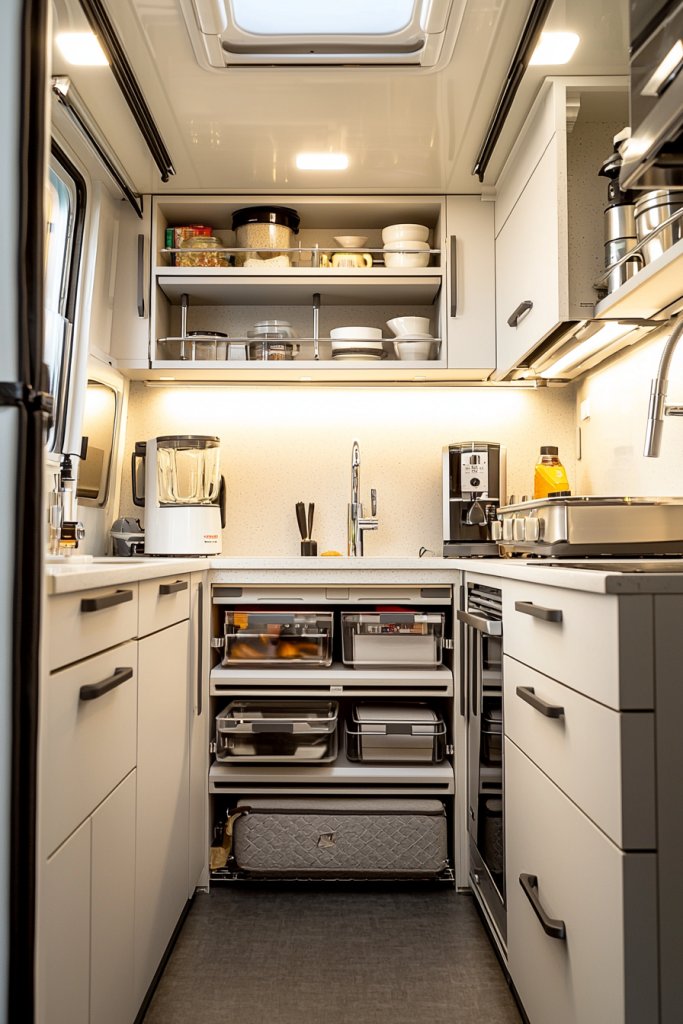
A tiny kitchen in a studio apartment demands clever design and smart storage solutions to keep cooking fun and clutter-free. Compact appliances, efficient organization, and multi-use fixtures can transform a cramped space into a functional culinary hub.
Visualize a small, streamlined kitchenette with a slim refrigerator, a two-burner cooktop, and a compact microwave all fitting seamlessly into a single wall or corner. Use wall-mounted racks and magnetic strips to hold utensils, knives, and spice jars, freeing up counter space.
Incorporate pull-out shelves or stackable containers inside cabinets to maximize storage. For surfaces, opt for light-colored, easy-to-clean countertops like quartz or laminate, which reflect light and make the space feel larger.
Implement this by choosing appliances designed for small spaces—think compact, energy-efficient models—and organizing your storage with clear, stackable containers. Install wall-mounted hooks and racks for frequently used tools.
Make sure to keep countertops clear for prepping, and consider adding a fold-down table or extendable countertop for dining or additional workspace. With a few strategic choices, your mini kitchen can be both stylish and highly practical.
9. Using Mirrors to Create the Illusion of Space and Brightness
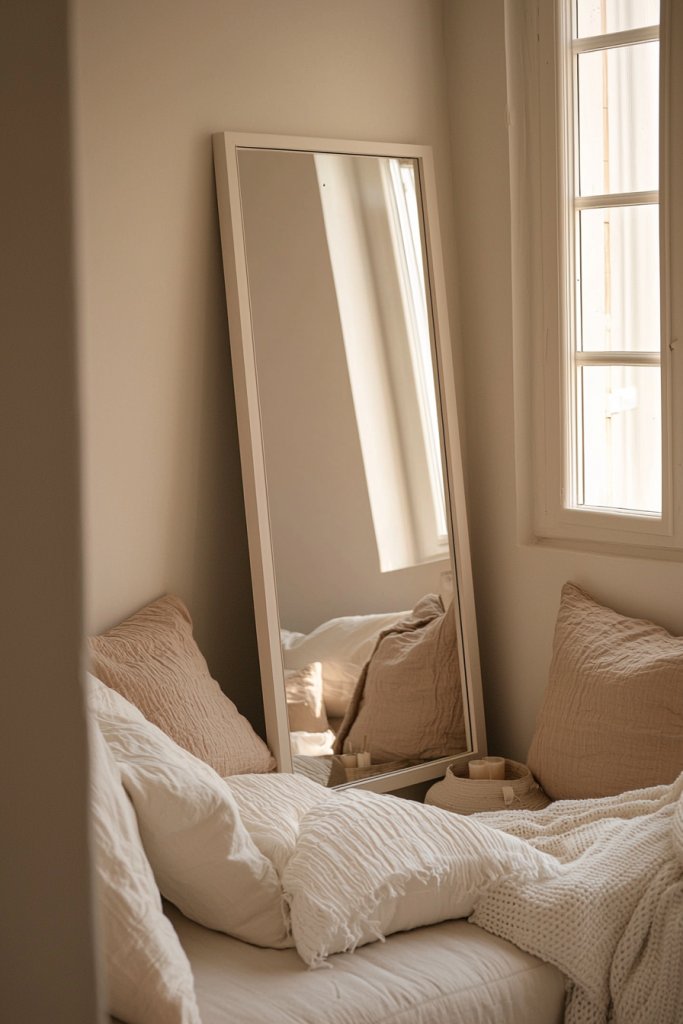
Ever wish your tiny studio felt bigger and more inviting? Mirrors are a game-changer for transforming compact spaces into bright, airy retreats by reflecting light and adding a sense of depth. They help your apartment appear more spacious without any major renovations, making them a must-have in small layouts.
Picture a large, sleek mirror with a frameless or minimalist metal frame hanging opposite a window, bouncing natural sunlight throughout the room. As light hits the mirror, it multiplies, illuminating every corner and creating a luminous glow that enhances the sense of openness.
Strategically placing a tall mirror behind your sofa or near the entryway can make the space feel twice as large, while decorative mirrors with interesting shapes or textured borders add visual interest. The reflective surfaces also bring a sense of movement and elegance, making your studio feel sophisticated and fresh.
To implement this idea, start with a versatile full-length or wall-mounted mirror—alternatively, a large decorative mirror with a stylish frame can add personality. Position it where it can catch natural light or reflect a focal point, like a window or a cozy reading nook.
You can also use multiple smaller mirrors arranged in a geometric pattern for a modern twist. Choose lightweight, shatterproof options for safety, especially in high-traffic areas. Simply hang the mirror using sturdy hooks or adhesive strips that won’t damage your walls, and enjoy the instant upgrade in brightness and space perception.
10. Efficient Closet Organization Systems to Maximize Storage
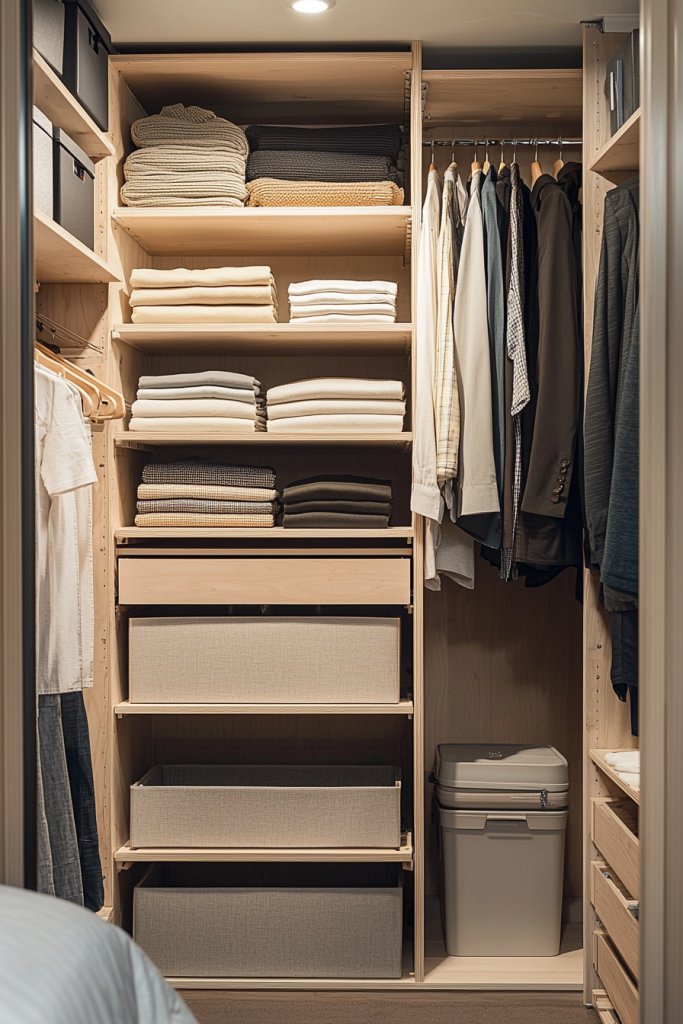
A cluttered closet can make a small studio feel cramped and chaotic, but smart organization turns this space into a sleek, functional haven. An efficient closet system not only maximizes storage but also makes it easier to find what you need, streamlining your daily routine.
Visualize a closet with adjustable shelves, hanging rods at different heights, and pull-out baskets—all designed to fit seamlessly into your available space. Use clear, labeled bins or woven baskets for smaller items like accessories, socks, or scarves, so everything has a designated spot.
Incorporate slim, space-saving hangers to maximize hanging capacity and consider installing a vertical organizer or cascading hooks for belts, ties, or jewelry. Combining these elements with a few hooks on the door or side panels adds extra storage without taking up floor space.
The result is a tidy, visually appealing closet that makes the most of every inch. To set up an efficient closet, start by decluttering—keep only what you wear regularly.
Measure your closet space carefully and choose modular or adjustable storage solutions that can be customized as your wardrobe evolves. Use stacking cubes or drawer dividers for folded clothes, and consider hanging a small, over-the-door organizer for shoes or small accessories.
For a budget-friendly option, repurpose clear plastic containers or tension rods. With a little effort, your closet will become a well-organized sanctuary that keeps your small space feeling fresh and clutter-free.
11. Placing a Compact Dining Area Without Sacrificing Space
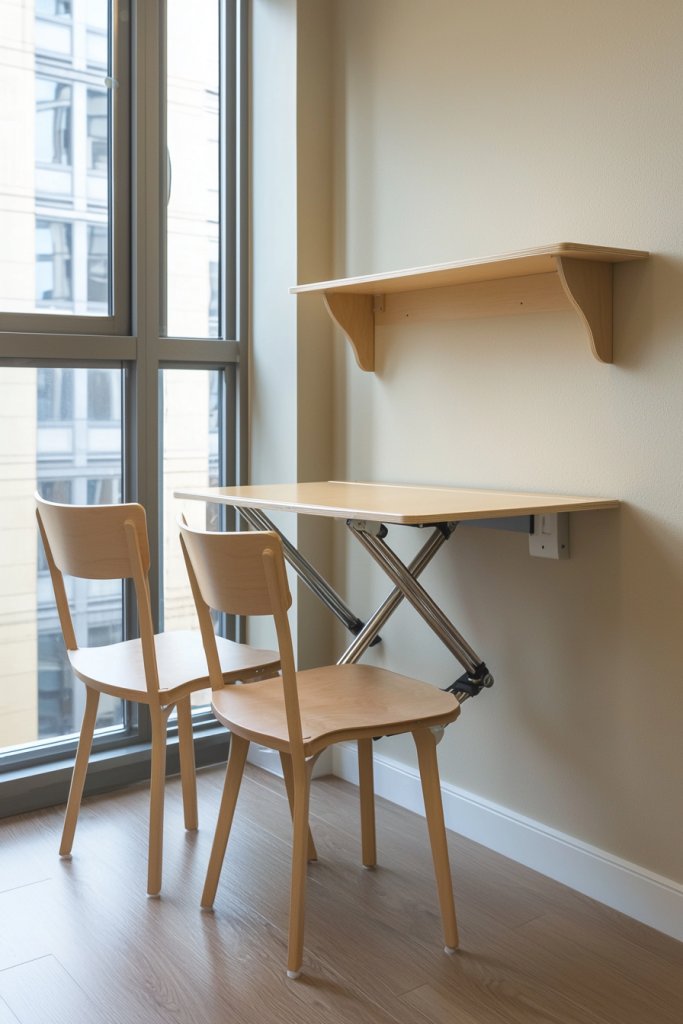
Creating a cozy, functional dining nook in a studio apartment can seem tricky—but with clever placement, you can enjoy meals without sacrificing valuable space. The key is choosing compact furniture and thoughtful positioning to keep the flow open and inviting.
Imagine a small round table with a sleek, foldable or drop-leaf design paired with two slim chairs or stackable stools tucked neatly underneath. Place this setup near a window or in a corner where it won’t block pathways—perhaps against a wall or in a nook created by a bookshelf or a curtain.
Use a light-colored or transparent glass tabletop to keep the area feeling airy, and add a soft, textured placemat or a small centerpiece like a candle or a bowl of fruit for warmth. If space is tight, consider multifunctional furniture like a fold-down wall mount table or a compact breakfast bar that doubles as counter space when not in use.
To implement this, measure your available space carefully and select a table that fits comfortably without overwhelming the room. Opt for lightweight, easy-to-move chairs or stools—preferably with slim legs and neutral tones.
Position your dining spot where it’s accessible but doesn’t block doorways or main walkways. Use wall-mounted or vertical storage nearby for utensils, placemats, and tableware to keep everything within reach but out of the way. With these simple adjustments, you can enjoy a dedicated dining area that enhances your small space’s functionality and style.
12. Stylish Divider Screens to Separate Living and Sleeping Areas
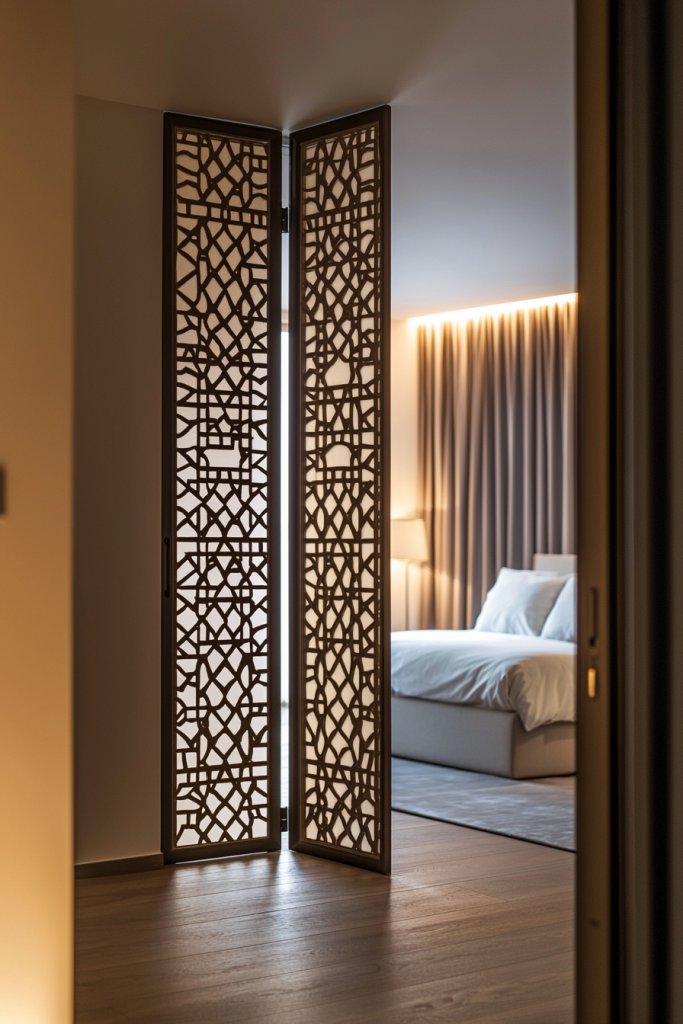
In a studio apartment, defining different zones—like living and sleeping areas—without sacrificing open-plan benefits is essential. Stylish divider screens offer a flexible, aesthetically pleasing solution that adds privacy and visual interest.
Visualize a lightweight, decorative folding screen with a pattern or texture that complements your decor—think bamboo, carved wood, or fabric with geometric or botanical motifs. It seamlessly separates your bed from the living space, creating a cozy nook that feels intimate yet open.
These screens can be moved easily, allowing you to open up the space for social gatherings or close it for privacy and rest. Incorporate neutral tones or pastel hues to keep the area feeling calm and spacious, and add layered textiles like a plush throw or textured cushions nearby to soften the division and add visual warmth.
To set this up, select a screen that fits your style and space—consider adjustable or collapsible options for maximum flexibility. Position it behind your bed or at the room’s entrance, ensuring it doesn’t block natural light or pathways.
For added stability, anchor the screen to the wall or use weighted bases if necessary. This approach not only creates a functional separation but also introduces a decorative element that elevates your entire apartment aesthetic. It’s an easy, affordable way to add privacy and style without building permanent walls.
13. Choosing Light, Reflective Finishes for a Bright, Spacious Feel
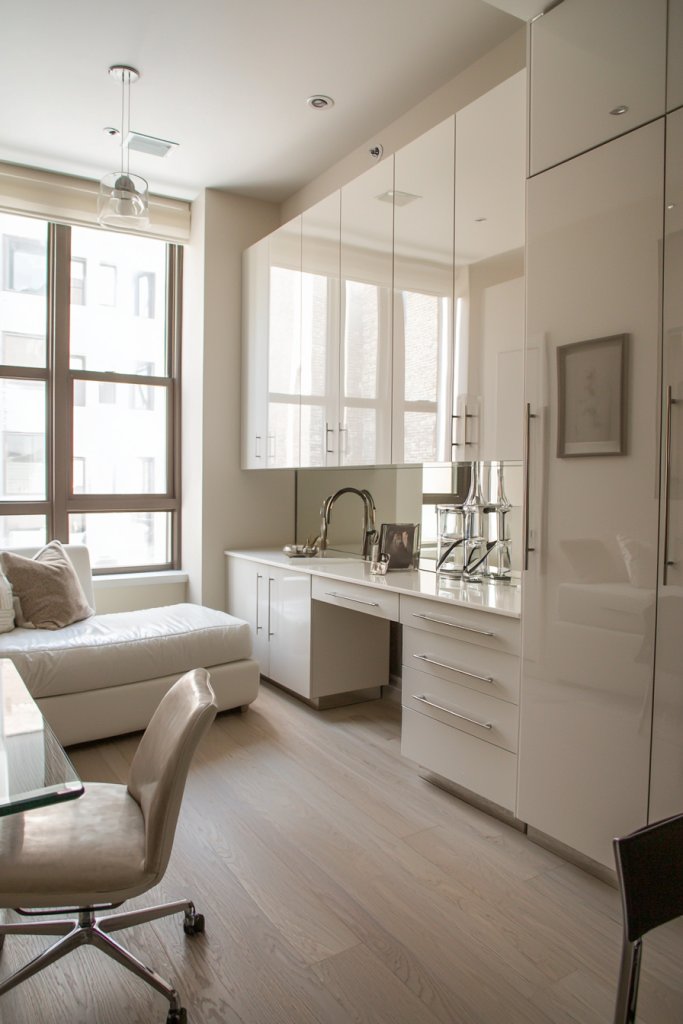
The right finishes can transform a small studio from cramped to expansive by bouncing light and creating a sense of openness. Light, reflective surfaces are key to achieving this airy, spacious atmosphere, making your space feel larger and more inviting.
Imagine walls painted in soft, neutral shades like warm beige, dove gray, or crisp white, which serve as a bright backdrop that amplifies natural light. Incorporate glossy or semi-gloss finishes on walls, cabinets, or trim to reflect light effectively.
Use reflective materials such as glass, polished metal fixtures, or high-shine tiles in your kitchen or bathroom to add subtle gleam and depth. Textiles like a soft, cream-colored throw blanket with chunky knit texture or a plush, light-colored area rug can also enhance the sense of warmth and openness.
Layering these finishes creates a cohesive, luminous environment that visually expands your small space. To implement, start with light-colored walls and ceilings, and choose furniture with sleek, shiny surfaces or light wood tones.
Incorporate metallic accents like brass or chrome in light fixtures, handles, or decorative objects for added reflectivity. Keep window treatments minimal—think sheer curtains or light blinds—to maximize natural light. By thoughtfully selecting these finishes and materials, you’ll craft a bright, welcoming studio that feels much larger than it actually is, perfect for relaxing or entertaining.
14. Incorporating Dual-Purpose Decor Items for Function and Style
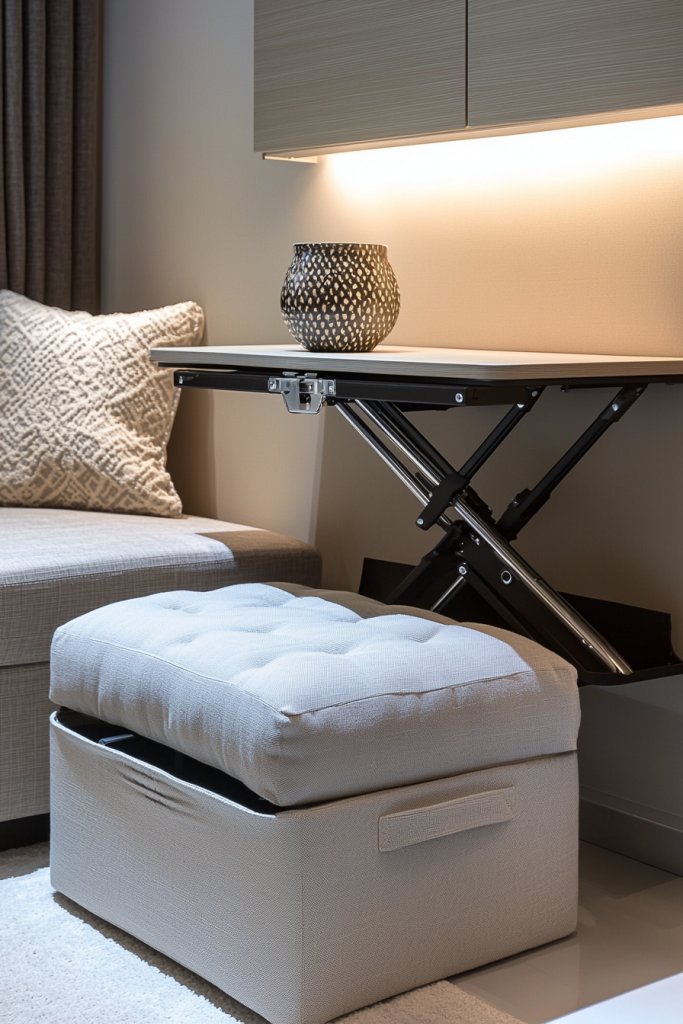
Transforming a small studio into a stylish, functional space often hinges on clever decor choices that serve multiple purposes. Dual-purpose decor items—like a chic storage ottoman or a decorative ladder that doubles as a towel rack—bring both form and function together seamlessly.
These pieces help reduce clutter while adding visual interest, making your apartment feel thoughtfully curated rather than cramped. Imagine a plush, velvet-upholstered bench at the foot of your bed that opens to reveal hidden storage for blankets and shoes.
Or picture a sleek ceramic vase that doubles as a lamp base, casting a warm glow over your living area. Incorporate textured textiles, such as a chunky knit throw or a woven basket, which add cozy tactile layers while also serving practical roles.
The key is selecting decor that complements your overall aesthetic—whether modern, bohemian, or minimalist—while maximizing every inch of space. To implement this, start by identifying items in your space that can be upgraded or repurposed.
Look for furniture with built-in storage, like a bed with drawers underneath or a side table with hidden compartments. Use decorative containers—like ceramic bowls or wooden crates—for organizing essentials on shelves or countertops. You can find many stylish dual-purpose pieces at affordable prices online or craft your own with simple DIY projects, like transforming a vintage suitcase into a side table with storage.
15. Arranging Furniture for Optimal Traffic Flow and Accessibility
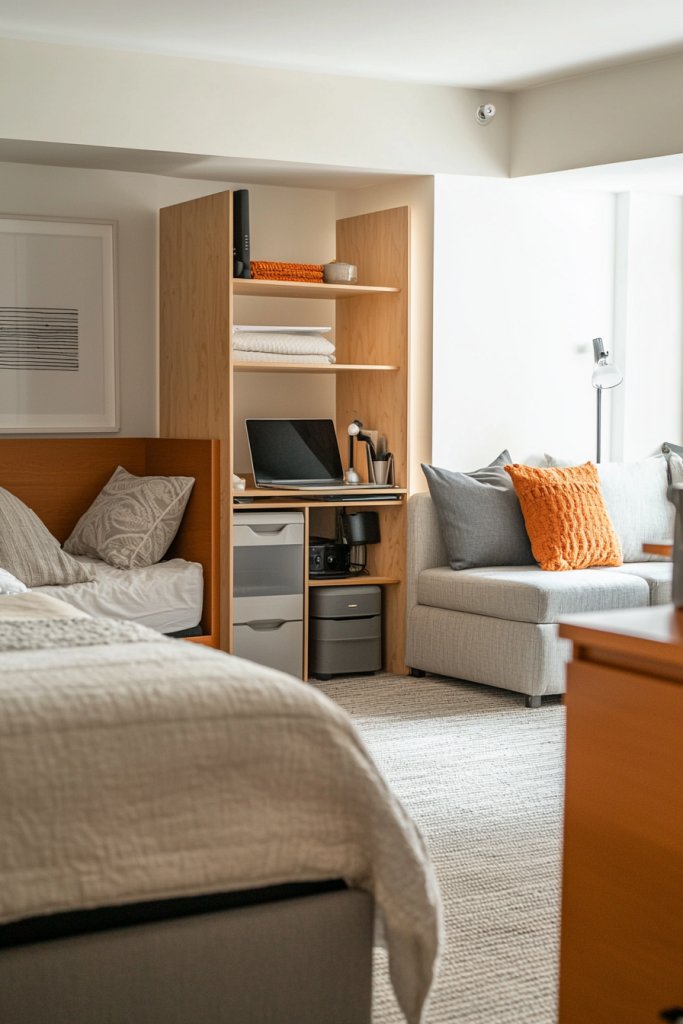
Creating a smooth, accessible layout in a studio apartment is essential for both comfort and efficiency. Proper furniture arrangement ensures that movement feels natural, without obstacles cluttering your walkways.
When furniture is thoughtfully positioned, your space appears larger, more inviting, and easier to navigate—perfect for everyday living or entertaining guests. Visualize your room as a well-organized flow: a sofa placed against one wall with enough space to walk around, a compact dining table positioned near the kitchen for easy access, and a bed tucked into a corner that doesn’t block pathways.
Keep main walkways clear—at least 24 inches wide—to allow effortless movement. Use furniture with slim profiles, like a streamlined armchair or a slender console table, to avoid overcrowding.
Incorporating multi-functional pieces also helps free up space, such as a fold-out sofa bed or a wall-mounted desk. To achieve this, sketch a basic floor plan before moving furniture.
Start by placing the largest items first—like the bed and sofa—and then arrange secondary pieces around them. Prioritize accessibility by keeping frequently used items within reach and avoiding tight corners.
Consider using lightweight, movable furniture pieces so you can experiment with different arrangements. This strategic approach not only maximizes space but also creates a harmonious environment that feels open and welcoming.
16. Adding Visual Interest with Textured Fabrics and Layered Textiles
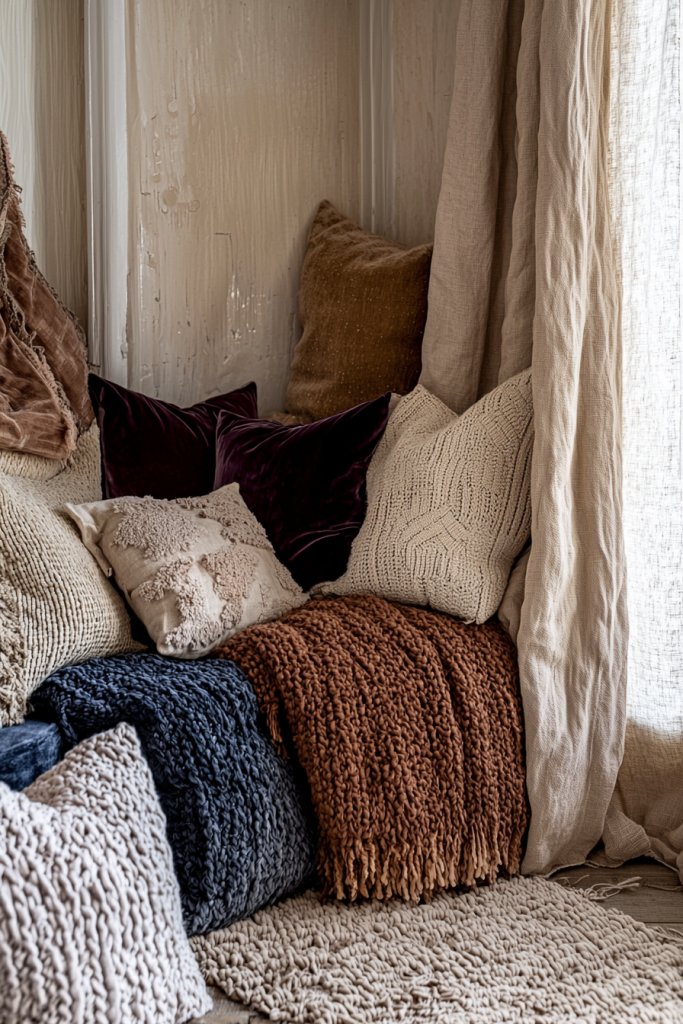
In a small studio, textures and textiles are your best friends for creating depth, warmth, and personality. Using a variety of textured fabrics—such as a plush velvet cushion, a chunky knit throw, or a silky curtains—adds visual richness and makes the space feel layered and inviting.
These tactile elements transform a plain room into a cozy haven that appeals to the senses. Picture a neutral-colored sofa adorned with a mix of throw pillows: some with a smooth satin finish, others with a rough woven surface or faux fur accents.
Layered textiles, like a shaggy rug beneath your coffee table or a soft, patterned blanket draped over your bed, enhance the sense of comfort and dimension. Rich textures contrast beautifully with minimalist furniture, drawing the eye and creating focal points.
Incorporate a balanced color palette—think muted earth tones with pops of deep berry or mustard—to keep the look cohesive. To implement this, select a few key textiles that complement your overall color scheme.
Mix and match different textures and patterns to keep things interesting, but avoid overwhelming the space. For example, combine a textured throw with smooth silk curtains and a plush rug.
Shopping at home decor stores or craft markets can yield affordable options, or you can even sew your own pillows or throws for a personalized touch. This layered approach makes your studio feel thoughtfully designed and endlessly inviting.
17. Utilizing Under-Elevated Platforms to Create Zoning and Storage
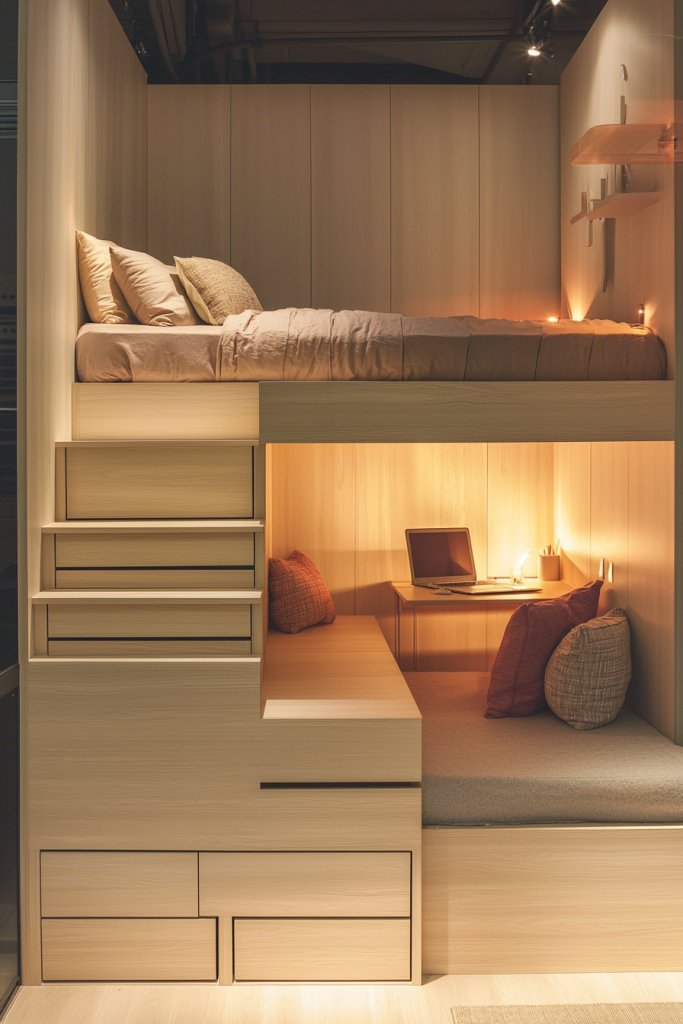
Elevating certain areas of your studio with under-platform zones is an innovative way to define different functions—like sleeping, working, or relaxing—without walls. These platforms create visual separation and can incorporate built-in storage, making your layout more organized and efficient.
It’s a clever trick to maximize vertical space while maintaining an open feel. Imagine a low, wooden platform that raises your bed slightly off the floor, with drawers or shelves built into the base for clothes, shoes, or books.
Alternatively, picture a raised seating area with storage underneath, demarcating your lounge space from your sleeping zone. The platforms can be customized with different materials—like plywood, reclaimed wood, or even carpeted bases—to match your aesthetic.
Adding soft lighting around or underneath the platforms enhances the mood and emphasizes zoning. To build or buy, start with a simple frame made from sturdy materials like plywood or metal.
Measure your space carefully to ensure the platform is proportional and safe. Incorporate drawers, cubbies, or open shelves underneath for easy access to stored items.
If DIY isn’t your thing, many furniture brands offer modular platform beds or risers that can be customized. This approach not only creates distinct zones but also offers hidden storage solutions, significantly freeing up your living space.
Conclusion
With a wide range of clever solutions—from multi-functional furniture and vertical storage to clever zoning techniques and stylish dividers—these studio apartment layout ideas offer endless possibilities to maximize both efficiency and style. By incorporating these strategies, you can transform even the smallest space into a functional, inviting home that reflects your personal flair.
Don’t be afraid to experiment and adapt these concepts to create a layout that perfectly suits your lifestyle. Start transforming your space today and enjoy the beautiful balance of form and function!
Leave a Reply